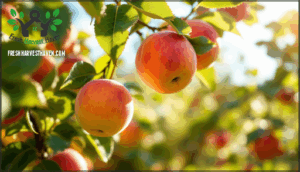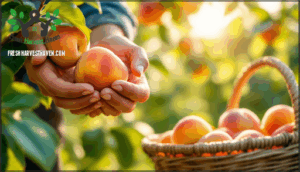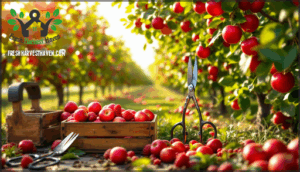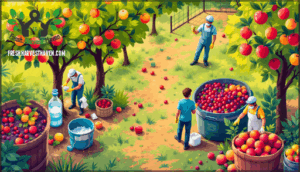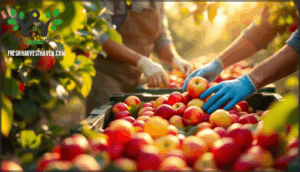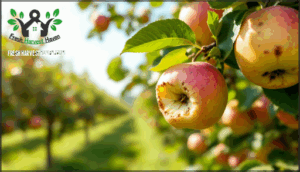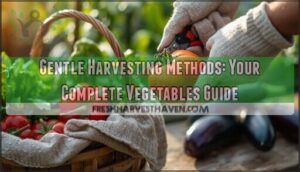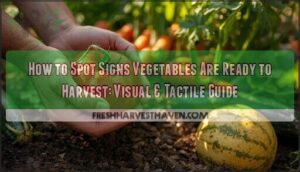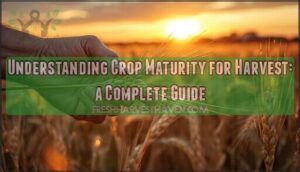This site is supported by our readers. We may earn a commission, at no cost to you, if you purchase through links.
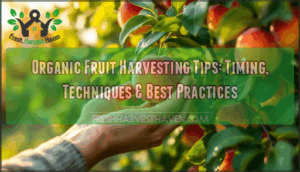
Organic fruit harvesting demands more precision than conventional methods because you can’t rely on chemical treatments to extend shelf life or mask damage. Your fruit must be picked at the right moment, treated with care, and moved quickly from tree to storage.
Getting these fundamentals right protects your certification, maximizes flavor, and turns your organic operation into one that actually makes money instead of just meeting standards.
Table Of Contents
- Key Takeaways
- Key Principles of Organic Fruit Harvesting
- Timing Your Organic Fruit Harvest
- Effective Organic Harvesting Techniques
- Post-Harvest Handling of Organic Fruits
- Overcoming Challenges in Organic Fruit Harvesting
- Frequently Asked Questions (FAQs)
- How do weather conditions affect organic harvest quality?
- Can organic fruits be harvested using mechanical equipment?
- How do you prevent bird damage during harvest?
- Which organic fertilizers work best for fruit trees?
- How do I train workers for organic practices?
- What are best companion plants for organic orchards?
- How can I improve soil fertility organically?
- Which organic fruits require hand pollination techniques?
- How do weather patterns affect organic yield?
- Conclusion
Key Takeaways
- Organic growers lose roughly 15% of harvest potential to poor timing and rough handling rather than pests, making precise picking schedules and gentle treatment more critical than in conventional operations that rely on chemical shelf-life extenders.
- Peak ripeness identification requires multiple indicators—color shifts, firmness testing with penetrometers, Brix sugar levels for grapes, and aroma checks—because organic fruit can’t mask damage or immaturity with post-harvest chemicals.
- Temperature control within 12 hours of harvest prevents most spoilage, with pre-cooling to 5.1–5.4°C cutting decay dramatically while delays that push temperatures to 17.6°C accelerate losses and waste organic-certified fruit.
- Equipment sharing among small growers reduces costs by up to 60% and pairs naturally with direct marketing through farmers’ markets, which raises profit margins 30–50% by capturing the premium consumers pay for certified organic produce.
Key Principles of Organic Fruit Harvesting
Harvesting organic fruit isn’t just about when you pick—it’s about following specific rules that protect the organic label you’ve worked so hard to earn. The USDA sets clear standards that shape every step of your harvest, from the tools you use to how you approach certification.
Let’s break down the core principles that keep your organic operation compliant and your fruit genuinely organic.
USDA Organic Standards for Fruit Harvest
Under USDA organic standards, your land can’t have prohibited substances for three years before harvest. You must avoid genetic engineering, radiation, and sewage sludge entirely. Build soil fertility through cover crops and compost, not synthetic fertilizers.
Your harvest equipment must prevent contamination between organic and conventional fruit and vegetables. Annual inspections verify compliance with the National Organic Program, documenting everything from field maps to wild harvesting zones.
Operations under $5,000 skip certification but follow the same rules for organic food production. Producers must adhere to the National Organic Program regulations.
Differences From Conventional Harvesting
Conventional farming practices lean heavily on synthetic pesticides—over 300 types—while organic systems ban all of them. That means you won’t use chemical treatments like growth regulators, fungicides, or post-harvest fungicide dips.
Yield outcomes generally run 80-95% of conventional totals, though harvest timing depends on natural ripening instead of chemical manipulation. Post-harvest care also differs: no wax coatings or preservatives, which can increase decay but slashes pesticide residues by over 90%.
Organic farming, in contrast, prioritizes overall system health.
Importance of Certification and Labeling
Certification isn’t just paperwork—it’s your market gateway. The USDA Organic seal confirms you’ve met strict federal standards, earning consumer recognition and label trust. In 2025, 74% of U.S. shoppers trusted this certification label above all others, and organic fruits commanded premiums from 15% to over 60% compared to conventional produce.
Organic certification opens premium markets—74% of shoppers trust the USDA seal, driving fruit prices 15-60% above conventional
To maintain certified organic status, you need:
- High compliance rates: Aim for 90%+ to avoid penalties and protect market access
- Traceability systems: Document every step from field to sale using government-approved certifiers
- Accurate labeling: Use "100% Organic" (all ingredients), "Organic" (95%+ ingredients), or "Made With Organic Ingredients" (70%+ minimum)
Strong compliance improves your financial health and keeps certification regulations working for you, not against you.
Timing Your Organic Fruit Harvest
Getting the timing right can make or break your organic harvest. You’ll need to know when each fruit hits peak ripeness, how seasons shape your picking schedule, and what environmental signals to watch for.
Let’s break down the key factors that help you decide when to head into the orchard.
Identifying Peak Ripeness for Common Fruits
You can’t judge a book by its cover, but you can judge a fruit by its color, texture, and aroma. Apples ripen when the skin shifts from green to yellow, while peaches display deep golden-yellow ground color. Strawberries need 75% red coverage for harvest.
Check firmness—ripe peaches yield to gentle pressure at 6-8 lb measured by penetrometer. Smell matters too; sweet fragrance signals readiness.
For grapes, test Brix sugar levels using a refractometer, targeting 16-20 for table varieties. Brown seeds in apples confirm maturity, protecting nutritional content and soil health investments by timing harvest right.
Seasonal Guidelines for Major Fruit Crops
Each season opens new windows for harvest, and matching your crop variety to the right calendar helps you protect both yield and organic integrity. Here’s your seasonal roadmap for major crops:
- Spring Berries: Strawberries start in Florida by January–February, while organic cherries peak May through early July in Washington and California
- Summer Stonefruit: Apricots arrive in June, followed by peaches and nectarines in July–August, keeping California markets supplied continuously
- Fall Apples: Prime picking runs September–October across major growing regions, with pears ripening slightly earlier in August–September
- Winter Citrus: Oranges and mandarins dominate December through March, supported by California’s stable irrigation and low disease pressure
- Regional Differences: Over 90% of U.S. organic apples originate in Washington due to dry conditions that limit fungal threats, while Florida sustains early harvests despite hurricane risks.
Organic farming methods depend on climate-adapted timing—arid western states extend harvests naturally without synthetic ripening agents, while eastern growers face tighter windows due to rainfall and disease.
Environmental Factors Affecting Harvest Timing
Beyond the regional patterns you’ve just reviewed, the environment itself acts like a moving target every season. Temperature impacts fruit weight and firmness—raspberries grown under elevated heat gained up to 28% more weight but lost sugar concentration and phenol content.
Rainfall effects swing wildly; some harvest windows in Tsuruoka saw zero rain while others logged over 100 mm in a single day, altering soil health and disease pressure overnight. Sunshine duration varied by 30 hours across years, speeding or stalling ripeness.
Frost risks and chilling injury threaten vulnerable crops like strawberries, especially as climate change disrupts dormancy cycles. Air quality, wind from typhoons, and ozone all degrade fruit surfaces and trigger premature drops, forcing you to adjust schedules constantly to protect biodiversity and ecological systems.
Effective Organic Harvesting Techniques
Once you’ve picked the right moment to harvest, the way you treat your fruit makes all the difference. Your technique determines whether you’ll end up with bruised, contaminated produce or unblemished organic fruit that fetches premium prices.
Let’s look at three core practices that keep your harvest clean, intact, and truly organic from tree to table.
Gentle Picking Methods to Prevent Bruising
Bruising can sneak up on you during harvest, but you can stop most damage by timing your pick to match fruit maturity. Harvesting avocados above 23% dry matter cuts bruising by 25%, while firmer blueberries bruise far less than overripe ones.
Keep drop heights below 10 cm and treat fruit with gentle pressure—under 10 N for apples reduces visible bruising by 23%. Temperature control matters too: cooling fruit immediately after picking reduces bruising ratios considerably.
Swift supply timing from field to packhouse preserves quality, cutting retail bruising by up to 17% in less than 48 hours.
Recommended Tools and Equipment for Organics
Choosing the right tools protects your organic certification while boosting hand tool ROI and cutting labor demands. Your equipment must align with USDA organic standards—think food-safe materials, non-toxic lubricants, and traceable maintenance logs that satisfy certification audits.
Special equipment pays off faster on smaller farms—hand tools show positive returns within two seasons, while mechanized harvesters suit orchards over 5 hectares practicing sustainable agriculture and soil conservation.
- Telescoping fruit picker poles (4–12 feet) let you reach high branches without bruising delicate fruit
- Stainless steel harvest scissors reduce berry removal damage by up to 60% while resisting rust
- Battery-powered ground harvesters process 2,000 lbs per hour, slashing costs from $2,500 to $1,200 per hectare
- Mechanical sorters with integrated debris removal cut food waste by 27% during grading
- Recycled aluminum tools and solar charging stations reinforce sustainability features in organic agriculture
Minimizing Contamination During Harvest
Protecting organic food from contamination starts with your workers—proper worker hygiene prevents pathogens from hitching a ride on your harvest. Handwashing stations slash cross-contamination by 70%, while non-porous gloves cut bacteria transfer by over half compared to bare hands.
| Contamination Risk | Control Measure | Impact |
|---|---|---|
| Unclean hands spreading E. coli | Worker handwashing stations | 70% reduction in contamination |
| Dirty harvest containers | Equipment sanitization protocols | 60% fewer surface bacteria |
| Livestock nearby fields | Animal intrusion fencing | 40% lower disease incidence |
| Contaminated rinse water | Water quality testing quarterly | Meets potable standards for food safety |
Your compost management matters too—manure aged over 6 months cuts fecal contamination risk by 75%. Water quality testing every three months keeps washing produce safe, while sanitized equipment prevents the pesticide residues lurking in shared tools from compromising your organic certification and environmental protection goals.
Post-Harvest Handling of Organic Fruits
Once your fruit is off the branch, your work shifts to keeping it clean, fresh, and organic-certified. Poor treatment can lead to quality losses between 1% and 20%, so the next steps matter as much as the harvest itself.
Here’s how to maintain your fruit’s integrity from field to market.
Chemical-Free Cleaning and Sorting Tips
Once your fruit and vegetables leave the field, they need proper cleaning without chemical exposure. Simple washing with running water removes soil and pesticide residues effectively, while natural sanitizers like vinegar-water mixtures eliminate up to 90% of surface microbes. Here’s how to maintain hygiene control while protecting organic integrity:
- Use physical cleaning methods like soft brushes and baking soda soaks to lift wax and residues without harsh chemicals
- Implement AI sorting systems that detect blemishes and grade fruit with 95% accuracy, cutting costs by 20%
- Follow wastewater treatment protocols when washing produce to prevent environmental contamination from cleaning agents
Safe Storage and Transportation Practices
Once your fruit and vegetables are clean, storage conditions become your next line of defense. Temperature control separates success from spoilage—most organic fruits need 0–10°C with 85–95% humidity to stay fresh.
Ethylene mitigation matters too: keep apples away from lettuce, or use potassium permanganate pellets to cut ethylene by 60–80%.
Sanitation protocols prevent cross-contamination between organic and conventional loads, while packaging solutions with active temperature controls reduce transit damage by 70%.
Cold chain logistics with continuous monitoring minimize microbial growth by 90%, protecting your organic food from field to market while reducing environmental impact and eliminating pesticide residues concerns through proper food labeling compliance.
Preserving Organic Integrity After Harvest
After establishing safe storage and transportation, maintaining organic integrity demands strict compliance throughout post-harvest management. Your management facilities must maintain organic certification, meeting USDA standards that prohibit synthetic pesticides, fungicides, or waxes.
Traceability protocols require dedicated containers and detailed recordkeeping—lot numbers, management procedures, and separation from conventional produce at every stage.
Sanitation standards permit only approved disinfectants like hydrogen peroxide for equipment cleaning, reducing fungal decay by up to 50%.
Quality monitoring through regular audits, temperature checks, and residue testing protects your organic food labeling and certification process while preserving what sets your harvest apart.
Overcoming Challenges in Organic Fruit Harvesting
Organic fruit harvesting comes with its own set of hurdles, from managing pests without chemicals to keeping costs down on a tight budget. You’ll face losses, labor constraints, and the constant pressure to protect your harvest without conventional shortcuts.
Here’s how to tackle three of the most common challenges and keep your organic operation running smoothly.
Natural Pest and Disease Management
When managing pests organically, you’ll want to lean on IPM frameworks that prioritize monitoring over routine pesticide use. Biological control—like predatory mites and lady beetles—can slash aphid populations by 50–80%, while botanical alternatives such as neem and kaolin clay reduce damage by 60–85%.
Cultural practices, including leaf removal and resistant cultivars, reduce disease pressure substantially.
Tech innovations like drone mapping improve scouting efficiency by 200%, helping you minimize pesticide use and environmental impact while protecting your harvest naturally.
Reducing Food Waste and Postharvest Losses
Beyond keeping pests at bay, you can’t afford to lose hard-won fruit after harvest. Temperature management stands as the single most decisive factor—pre-cooling to 5.1–5.4°C within 12 hours cuts spoilage dramatically, while lapses push temperatures to 17.6°C and accelerate decay.
To minimize losses:
- Train your crew in proper care and storage; knowledge transfer directly reduces on-farm waste.
- Build market linkages during peak harvest to move surplus quickly and avoid gluts.
- Explore waste valorization by turning peels and pomace into value-added products.
Open-stock sustainable packaging slashes plastic use by 98.8%, lowering your environmental impact while preserving organic integrity from field to fork.
Cost-Effective Tips for Small Organic Growers
When budgets are tight, pooling resources with other growers cuts equipment costs by up to 60%. Shared harvesters and mulch layers slash labor hours while preserving capital for organic farming methods like compost and cover crops.
Pair equipment sharing with financial planning and drip irrigation to trim water use by 60%. Replace synthetic inputs with integrated pest management to save 28% per season.
Direct marketing through farmers’ markets raises margins 30–50%, turning your fruit and vegetables into premium organic agriculture products that reward careful stewardship.
Frequently Asked Questions (FAQs)
How do weather conditions affect organic harvest quality?
Rain impacts fruit quality by increasing disease risk and splitting delicate skins. Humidity levels promote fungal growth. Wind damage bruises crops.
Temperature effects ripeness—extreme heat accelerates decay, while cold slows maturity.
Sunlight exposure boosts sugar content, improving crop yields in organic farming methods.
Can organic fruits be harvested using mechanical equipment?
Like a gentle hand picks a peach, machines can harvest organic fruits—but only when Mechanical Suitability, Damage Prevention, and Cost Analysis align.
Robotic Harvesting systems respect agricultural standards and organic farming methods while addressing Efficiency Concerns and environmental impact of farming.
How do you prevent bird damage during harvest?
Protect your fruit with bird netting over rows or individual trees—it’s your most reliable defense.
Combine visual scare tactics like reflective tape and decoys with sound deterrents, rotating them regularly so birds don’t adapt.
Modifying habitat by removing nearby perches and planting alternative food sources can redirect birds away from your crop without harming wildlife or compromising organic standards.
Which organic fertilizers work best for fruit trees?
Compost tea and bone meal deliver steady nutrients without synthetic inputs. Well-aged manure types—poultry, cow, or composted horse—build soil fertility naturally.
Cover crops boost nutrient cycling between harvests, sustaining organic farming practices and long-term fruit tree health.
How do I train workers for organic practices?
Training workers is like planting seeds—you reap what you sow. Start with hands-on farm management sessions covering certified organic agriculture standards, safety protocols, and ethical harvesting techniques.
Emphasize continuous improvement through organic certification process education and animal welfare standards where applicable.
What are best companion plants for organic orchards?
Companion planting strengthens organic orchards through nitrogen fixation, pest control, and pollinator attraction. Clover and vetch build soil health naturally, while marigolds and nasturtiums repel harmful insects.
These integrated farming practices improve sustainable food production and reduce environmental impacts.
How can I improve soil fertility organically?
Healthy soil is your orchard’s foundation. Add compost regularly to boost organic matter and composition, then plant cover crops like clover or vetch as green manures between rows.
Rotate crops when possible and apply natural soil amendments to build sustainable fertility while reducing the environmental impact of farming.
Which organic fruits require hand pollination techniques?
Pollination challenges arise with fruits like kiwi, vanilla, and certain fig varieties—they won’t set fruit reliably without your help. Hand-pollination benefits organic food production by boosting yields when natural pollinators are scarce, guaranteeing organic certification standards are met without pesticides while supporting soil and natural fertility building through successful harvests.
How do weather patterns affect organic yield?
Weather patterns shape organic yield through rainfall patterns and temperature impacts on crop development. Climate change and extreme weather bring seasonal shifts that stress plants, reducing harvest quality.
Organic farming relies on environmental quality, making food production vulnerable to these weather-driven changes.
Conclusion
Here’s the reality: organic fruit harvesting tips aren’t about idealism—they’re about survival. When you nail timing, treat fruit like it matters, and move fast from field to cooler, you stop hemorrhaging profit.
Your certification stays intact, your customers taste the difference, and your operation breaks even instead of breaking you.
Master these practices and you’ll prove that organic doesn’t mean fragile—it means disciplined, deliberate, and worth every careful motion.
- https://immigrantstable.com/10-sustainable-fruit-picking-practices/
- https://www.choicesmagazine.org/choices-magazine/theme-articles/emerging-technologies-theme/mechanization-efforts-in-fruit-harvesting
- https://newprairiepress.org/cgi/viewcontent.cgi?article=1083&context=ufss
- https://aglab.ars.usda.gov/sights-and-sounds-fuel-your-curiosity/harvesting-apples-2025
- https://www.farmprogress.com/organic-grower-summit/tech-a-labor-saving-solution-for-organic-growers

